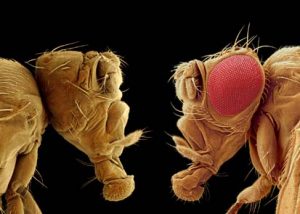Making science visible
Scientific topics and ideas can be very complex. That makes them difficult for non-experts to grasp. By visualizing abstract concepts, images can help to make them easier to understand. The following images are examples of how visual science can be.
Wild-type meets mutant
 This image shows two fruit flies (Drosophila melanogaster) facing each other. The fly on the right is a normal (wild-type) fly, whereas the one on the left is a mutant. In the mutant, a gene which is essential for the formation of eyes is defective. Flies lacking this gene don’t develop eyes.
This image shows two fruit flies (Drosophila melanogaster) facing each other. The fly on the right is a normal (wild-type) fly, whereas the one on the left is a mutant. In the mutant, a gene which is essential for the formation of eyes is defective. Flies lacking this gene don’t develop eyes.
The gene in question, Pax6, can be found in virtually all animals: in human, flies, molluscs and even very simple worms. It is a very powerful gene. If expressed in the wrong place, say the legs or the wings of a fly, eyes will form in these locations. Pax6 is therefore called a master regulatory gene of eye development: it alone is sufficient to induce the formation of eyes in a given part of the developing embryo.
Moreover, this gene is very similar between different species. If the Pax6 gene from a mouse is inserted into a mutant fly lacking the fly Pax6 gene, the fly will develop eyes again. The mouse gene can “rescue” the fly mutant.
This picture won the first prize in the competition “Bilder der Forschung” (“Images of Science”) organised by the national German news magazine Focus and the German Association of Research-based Pharmaceutical Companies. It was also chosen as the cover image for the textbook Principles of Development by Luis Wolpert et al., 3rd edition, Spektrum Akademischer Verlag, Heidelberg, 2007.
Copyright by Jürgen Berger and Ralf Dahm, Max Planck Institute for Developmental Biology, Tübingen, Germany.